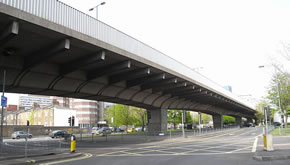TfL To Spent 60 Million Pounds Strengthening Hammersmith Flyover
Contract for work awarded to engineering firm Costain
Transport for London has agreed a contract worth £60 million to strengthen Hammersmith Flyover.
Engineering firm Costain will carry out repairs to strengthen the 50-year-old crumbling structure, and include work to replace bearings, waterproof and resurface the deck, and replace the bridge’s drainage system.
The flyover on the A4, which links west London to the M4 and the centre of the capital, was shut for a month in December 2011 to repair damage to the supporting cables.
The damage to the ageing 1960s structure was caused by water ingress, including salt water due to grit laid during the winter months, which corroded and weakened the cables.
Andrew Wyllie, Chief Executive of Costain, says:
" Costain is delighted to gain a place on TfL’s framework, and to commence work on the Hammersmith Flyover which is a technically challenging structure and an important part of London’s infrastructure."
However, Hammersmith and Fulham Council points out that Since its emergency closure, serious questions have been asked about the flyover’s long-term viability given the escalating costs of maintenance and increased risk of failure.
News of these new works comes just weeks after local architects and residents gave their support to getting rid of the flyover and replacing it with a ‘flyunder’ – which would be London’s first major road tunnel for 20 years.
Leader of Hammersmith & Fulham Council, Cllr Nicholas Botterill, said: “We know that vital repairs are necessary to the flyover but this needs to be the last time TfL spends a huge amount of taxpayers’ money on maintaining this monstrosity. Any other cash set aside for future work to the flyover needs instead to be pumped into making the flyunder a reality.
“A new tunnel solution would dramatically improve the quality of life for thousands of west Londoners and link the riverfront with Hammersmith town centre for the first time since the 60s.”
The tunnel proposals have also been backed by architect Lord Rogers, best known for designing the Pompidou Centre and the Lloyd’s building in the City, through his practice Rogers Stirk Harbour & Partners. The firm’s headquarters are on the banks of the Thames just a few hundred yards from the flyover.
Senior partner, Mike Davies, said: “The removal of the space-gobbling, light-blocking, community-dividing flyover would offer opportunities for new public space in the form of light and air and with hugely reduced pollution.”
The suggested flyunder could eventually see a tunnel from the Hogarth roundabout in Chiswick to the Earl’s Court end of the current flyover. Burying the A4 would restore links between Hammersmith and Chiswick town centres and the Thames and could be achieved without disruption to the highway network, according to West London Link. Construction costs could be financed by the prime land that would be released for development.
The council says it intends to commission a study to ascertain the benefits and challenges related to various options.
Garrett Emmerson, chief operating officer for surface transport at TfL, says: " We understand that H&F Council is keen to look at proposals to replace the Hammersmith flyover in more detail. We have discussed this with the borough recently and offered support to them in putting their case together for this project.
"Any plan to replace the flyover would need to be fully assessed, justified and funded through the wider redevelopment of the area."
June 4, 2013
